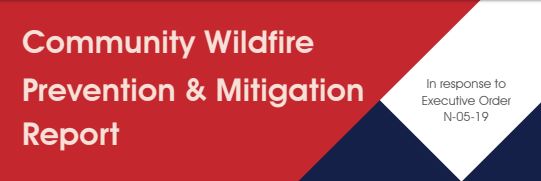 Just released — See the full report here: 45-Day Report-FINAL CalFIRE
Just released — See the full report here: 45-Day Report-FINAL CalFIRE
Executive Summary
California experienced the deadliest and most destructive wildfires in its history in
2017 and 2018. Fueled by drought, an unprecedented buildup of dry vegetation
and extreme winds, the size and intensity of these wildfires caused the loss of
more than 100 lives, destroyed thousands of homes and exposed millions of
urban and rural Californians to unhealthy air.
Climate change, an epidemic of dead and dying trees, and the proliferation of
new homes in the wildland urban interface (WUI) magnify the threat and place
substantially more people and property at risk than in preceding decades. More
than 25 million acres of California wildlands are classified as under very high or
extreme fire threat, extending that risk over half the state.
Certain populations in our state are particularly vulnerable to wildfire threats.
These Californians live in communities that face near-term public safety threats
given their location. Certain residents are further vulnerable given factors such
as age and lack of mobility. The tragic loss of life and property in the town of
Paradise during the recent Camp Fire demonstrates such vulnerability.
Recognizing the need for urgent action, Governor Gavin Newsom issued
Executive Order N-05-19 on January 9, 2019. The Executive Order directs the
California Department of Forestry and Fire Protection (CAL FIRE), in consultation
with other state agencies and departments, to recommend immediate,
medium and long-term actions to help prevent destructive wildfires.
With an emphasis on taking necessary actions to protect vulnerable
populations, and recognizing a backlog in fuels management work combined
with finite resources, the Governor placed an emphasis on pursuing a strategic
approach where necessary actions are focused on California’s most vulnerable
communities as a prescriptive and deliberative endeavor to realize the greatest
returns on reducing risk to life and property.
Using locally developed and vetted fire plans prepared by CAL FIRE Units as a
starting point, CAL FIRE identified priority fuel reduction projects that can be
implemented almost immediately to protect communities vulnerable to wildfire.
It then considered socioeconomic characteristics of the communities that would
be protected, including data on poverty levels, residents with disabilities,
language barriers, residents over 65 or under five years of age, and households
without a car.
In total, CAL FIRE identified 35 priority projects that can be implemented
immediately to help reduce public safety risk for over 200 communities. Project
examples include removal of hazardous dead trees, vegetation clearing, creation of fuel breaks and community defensible spaces, and creation of
ingress and egress corridors. These projects can be implemented immediately if
recommendations in this report are taken to enable the work. Details on the
projects and CAL FIRE’s analysis can be found online at
http://calfire.ca.gov/fire_prevention/downloads/FuelReductionProjectList.pdf ,
which will remain updated in the coming months. The list of projects is attached
to this report as Appendix C.
CAL FIRE has also worked with over 40 entities including government and nongovernment stakeholders to identify administrative, regulatory and policy
actions that can be taken in the next 12 months to begin systematically
addressing community vulnerability and wildfire fuel buildup through rapid
deployment of resources. Implementing several of these recommended actions
is necessary to execute the priority fuel reduction projects referenced above.
Other recommendations are intended to put the state on a path toward longterm community protection, wildfire prevention, and forest health.
The recommendations in this report, while significant, are only part of the
solution. Additional efforts around protecting lives and property through home
hardening and other measures must be vigorously pursued by government and
stakeholders at all levels concurrently with the pursuit of the recommendations in
this report. California must adopt an “all of the above” approach to protecting
public safety and maintaining the health of our forest ecosystems.
It is important to note that California faces a massive backlog of forest
management work. Millions of acres are in need of treatment, and this work—
once completed—must be repeated over the years. Also, while fuels treatment
such as forest thinning and creation of fire breaks can help reduce fire severity,
wind-driven wildfire events that destroy lives and property will very likely still
occur.
This report’s recommendations on priority fuel reduction projects and
administrative, regulatory, and policy changes can protect our most vulnerable
communities in the short term and place California on a trajectory away from
increasingly destructive fires and toward more a moderate and manageable
fire regime.